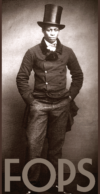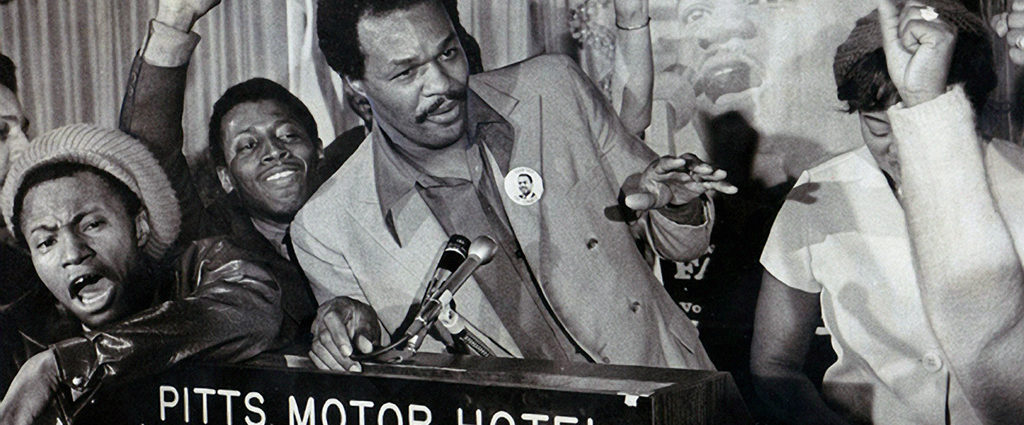The People and the Police: Washington D.C.’s Police-Community Relations Program, 1968
“The question always comes when you live in a community that’s oppressed and people are living like we have to live in the black community, how do you get a handle on all these problems? And you solve them by trying to create in the citizens an awareness of a need for dramatic and drastic change in this community.”
-Marion Barry Development of Community Control, 1971 (Local Identifier: 381-P-3)
Washington, D.C.’s Pilot District Project
Just months after the 1968 assassination of Martin Luther King, Jr. and the riots that devastated Washington, D.C., the Office of Economic Opportunity (OEO) introduced a program intended to bring the city together.
OEO created The Pilot District Project, established in the Third District, to foster the development of community programs and improve the shattered relationship between the city’s citizens and its police force. As part of the ambitious project, the government agency contracted with Guggenheim Productions to produce a documentary and a series of training films that could be used when they rolled the program out to other cities around the country. Although OEO spent $197,879 to make the films, they were never released.[1]

The Office of Economic Opportunity was the agency created to stand up poverty-reducing programs sketched out in the Economic Opportunity Act of 1964, a major component of President Lyndon Baines Johnson’s War on Poverty. Although the agency was broken up and dissolved by the 1980s, many of the programs it started are still in existence fifty years later. Head Start, the VISTA volunteer program, and Job Corps are a handful of the most successful. The Economic Opportunity Act also established Community Action Programs that gave the keys to change to community members, ostensibly with the belief that empowering citizens would be the most efficient way to bring about real change. A string of riots in American cities in the late 1960s exposed a deeply dysfunctional relationship between urban communities and the police: reports showed antagonism, prejudice and brutality from the police, and hostility, distrust, and contempt from the community.[2] OEO created the Pilot District Project to address this major problem.
These are the barest facts of the Pilot District Project and the films that we’re featuring in today’s post. The fact that the Office of Economic Opportunity was willing to plunk down what today would be over one million dollars for films that no one ever saw is remarkable, and not just because that’s an awful lot of money a product that was almost immediately warehoused in Suitland, Maryland.
That kind of investment shows that OEO believed they were undertaking a project that would transform police-community relations, one that would serve as a model for the rest of the country. Officials may have been overly optimistic, and the film project was certainly held up as an example of government waste at the time, but what’s easier to see in hindsight is that CG 8225: The People and the Police is an exceptionally well-crafted film that serves as a record of the Washington, D.C. community and the turmoil it was experiencing in the late 1960s. OEO may not have gotten what they wanted from the program or the film production, but more than forty years later, we all can benefit from this $200,000 mistake.

CG 8225: The People and the Police
CG 8225: The People and the Police (Local Identifer: 381-P-1) begins with more than a minute of atmospheric shots of a poor section of the city waking up; pigeons coo while a man sleeps on a bench, businesses are unshuttered, and children start the walk to school. The film then cuts to two policemen in a cruiser. The officers discuss why it might be that they are perceived negatively. They agree that it’s likely only a small segment of the population that are the source of the problem, the citizens who commit crimes, who they don’t consider a part of the community anyway. The next logical jump would be that the police don’t actually have a problem with the community at all.
The film then switches to interviews with a range of black citizens, from the youth who complains that the police use racial slurs, to the older man who, with tears running down his cheeks, explains that the businesses are boarded up because they were burned during the riots. His final comment implies that although it was the riot that destroyed his business, the cops fled rather than try to impose order.
The Pilot District Project is then introduced with a few explanatory titles. Director Robert Pierce did not use a voice over and does not tell the viewer what to think of the project. One might expect that as the film unfolds, we will see how the differences between the police and the community were bridged. Certainly that was the intention of the program. What we actually get is an hour’s worth of footage covering a three-year period of meetings, protests, and interviews, and an endless struggle between the community, the police, and the program’s administrators over who would have the most control over the project.

The lack of real power in the Citizens’ Advisory Board was the main concern of many of the community leaders who were appointed by the mayor to initiate the project. In fact, Charles Cassell, a D.C.-based architect and activist, provides what is probably the best sound bite of the entire film when he resigned over this very issue:
“We in the black community see the police as enemies and I remind everybody here that I may very well be shot as I walk out of that door if I happen to anger some white policeman. I’m very much aware of that and every black person is and therefore we want to control those individuals, especially since the central police force is not even capable of recruiting the capable black men in this black city and has to go out to places like Odd, West Virginia and find individuals who have very questionable backgrounds. I, Charles Cassell can no longer serve on a committee which cannot possibly make changes if it functions only in an advisory capacity. I see a constant recurrence of the conflict between the police and the community until the community finally has some measure of control over the police, and that means to make decisions.” (at 11:40)
In a November 3, 1968 article in the Washington Afro-American, Cassell followed up to say that “the pilot project is no more than something to verify and give credibility to the police department as it now exists.”
Prominent in the film is the tireless Marion Barry, who would become Washington’s “Mayor for Life.” In 1968 Barry was an established activist and ran a non-profit that employed out-of-work black youth. In many ways, the film becomes the Marion Barry Show as he attempts to wrest control of the project for the community. Barry’s presence is strong in the film, from the early planning meetings to organizing protests of the project’s first director, Dr. Robert Shellow. Barry eventually became chairman of the Citizens’ Advisory Board. His voice is used to narrate the short film Development of Community Control.

Unfortunately, the Pilot District Project never really took off. Many of the program’s shortcomings are on display in the hour-long film. It was simply not designed to address the stark inequality that existed in the city. In addition, it is clear that the community was not a united front. Throughout there are contingents of activists, businessmen, and what for lack of a better term I’ll call “little old ladies” that all have different beliefs about how to best guide the program or even what the community should be trying to achieve.
The government agency that created the Pilot District Project was also mired in bureaucracy, so it was perhaps destined to devolve into yet more bureaucracy once the board was elected. Meeting after meeting is shown to devolve into raised voices, debates over bad accounting, and even direct criticism of the wasting of precious time on parliamentary procedure. One unidentified man expresses his frustration at the February 13, 1971 meeting:
“I’m not on the board. I’m not on any of these committees. This is about the umpteenth meeting I’ve been to and I’ve noticed that all of these meetings are being taken up by bureaucratic procedures and Robert’s Rules of Order. And I noticed another thing–it seems like the black people here are scared to say anything. I don’t know that one Robert’s Rules of Order, one board meeting, has ever stopped a policeman’s bullet, or a policeman’s club from beating the hell out of a black person. Nothing is going to take place until black people get up off their a-ses in these meetings and begin to ask some relevant questions about this operation.” (at 47:51)
Toward the end of the film, several of the projects established with the project are demonstrated. A citizen rider program shows members of the community riding along with police to gain a better understanding of their work. Other community members listen to citizens’ complaints and problems. A young man in the Cadet Escort Service helps an elderly man buy his groceries. The program appears to have yielded some successes, although a 1972 report from the National Institute of Law Enforcement and Criminal Justice criticizes the citizen rider program and points out that with the services being grant-dependent, they cannot possibly respond to the constantly-changing needs of the community.[3]

It’s not surprising, then, that when Guggenheim Productions delivered the film, plus three short “training films,” OEO had no interest in letting them see the light of day. A 1973 article in the Washington Post quotes Barry Locke, the OEO director of public affairs in saying that the agency did not have a clear plan for the filmmakers: “When you undertake a film project, you should determine what audience it should serve and how to distribute it before you shoot it. Apparently the people involved in the 1968 decision to make the film didn’t.” Director Robert Pierce explained that “OEO was not satisfied with the results because it didn’t make a positive statement.”[4]
The People and the Police, Forty-Seven Years Later
Looking through the National Archives’ file, it is clear that the OEO was trying to rid itself of the film project almost as soon as it was completed. The final date cited in the film is April 15, 1971. By December of that year, correspondence shows OEO had already begun to initiate transfer of the films and 53 boxes of associated material. Usually the Archives doesn’t receive records until decades after an agency creates them.
Today, we can be grateful that the OEO sent the films to the National Archives rather than stick them in a closet and try to forget about them. CG 8225: The People and the Police, along with its three short companion films, are valuable historical records of a specific time and place in American history that we can’t help but connect to the present. Washington, D.C. is not Ferguson, Missouri, and 1968 is not 2015, but these films are an example of how we can look to the past to find out not just what happened, but to recognize issues that nearly fifty years later, our nation still struggles to confront.

